
On January 16, 2018, Jason Winged writes on Forbes:
In a 2015 Reddit Ask Me Anything (AMA), the late Stephen Hawking warned of the extraordinary power of artificial intelligence (AI). “The real risk with AI isn’t malice but competence,” he wrote. “A superintelligent AI will be extremely good at accomplishing its goals, and if those goals aren’t aligned with ours, we’re in trouble.”
Since then, AI’s presence and capabilities have expanded significantly — and will continue to do so at exponential rates. As Hawking urged, humans must pursue AI with purpose and forethought. In the coming years, that responsibility will fall not only on politicians and engineers — but also on business leaders.
When MIT Sloan Management Review and BCG Henderson Institute surveyed 3,000 global executives, 85% believed that AI will allow their companies to “obtain or sustain a competitive advantage.” According to PricewaterhouseCoopers (PwC), 20% of companies plan to deploy AI enterprise-wide in 2019.
While they may be aware of the transformative powers of AI, are these leaders truly prepared for the changes they will soon face in their businesses?
In the aforementioned BCG/MIT survey, of the 60% of respondents who viewed AI strategy as “urgent” for their organizations, only half already had one in place. In a 2017 Deloitte survey, only 17% of executives were familiar with both the concept of AI and its applications at their companies.
The world is changing rapidly, and leaders must strive to introduce AI in ways that are effective and sustainable. It is imperative for forward-thinking leaders to invest time, energy, and resources into learning about the implications of AI for their industries and their organizations. Here are three specific areas where leaders can expect to see significant AI-driven changes in their daily business practices.
1. Amplifying the Core Business
Nearly three-quarters (73%) of C-level executives agree or strongly agree that AI has already transformed the way they do business, according to an Infosys report.
One such company is Morgan Stanley. The investment firm created an AI-supported “next best action” tool that allows brokers to send customized messages to hundreds of clients at once. As American Banker reported, the tool ascertains the clients’ asset allocation, tax situation, preferences, and values in mere seconds. Advisers can then evaluate the results and determine what information and which recommendations they will share with the client.
Pfizer provides another example of a company that integrates AI into its core business activities. In December 2016, the pharmaceutical giant partnered with IBM’s “Watson for Drug Discovery” to accelerate research into immuno-oncology drugs. It is using AI to analyze public and proprietary data, analyze and test hypotheses, and assess safety. Other pharmaceutical companies are embracing similar approaches.
AI will also have broad, industry-agnostic consequences for business operations across industries — one of which will likely be increased internal collaboration. Immense amounts of data are required for AI to function, and in many companies, that data is currently fragmented. As AI becomes commonplace, data structures will need to change to fully realize the benefits of AI approaches in daily business practices.
A 2018 PwC report stated that “some forward-thinking organizations are already breaking down the silos that separate data into cartels and employees into isolated units,” and warned that failure may await those who don’t. The BCG/MIT report, too, affirmed that “a hybrid model emphasizing cross-functional collaboration may make the most sense” for businesses integrating AI.
2. Recruiting, Hiring, and Managing Talent
One department where AI is already having a measurable impact is human resources. In Deloitte’s 2018 report on human capital trends, 47% of respondents reported that their companies were “deeply involved in automation projects.” Nearly one-quarter (24%) were using AI and robotics to perform routine tasks, and 16% were applying it to “augment human skills.” A small portion (7%) of the respondents indicated that they were using AI to “restructure work entirely.”
Human resources is a logical area for companies to introduce AI, as it can serve a myriad of functions: reducing human bias during initial screenings, sifting through resumes and social media, and helping with routine processes like training, onboarding, and evaluation. Of those HR/AI functions, recruiting might be the most utilized. One survey of talent acquisition professionals found that 62% planned to spend money on AI-powered recruiting software in 2018.
IBM, a company long at the forefront of AI, has been using its chatbot Watson Candidate Assistant in its own recruiting efforts. Watson engages with candidates on the IBM website, assessing their interests and recommending openings that are a good fit. The company reported that 86% of individuals interacted with the chatbot. IBM offers Watson’s services to external companies, as well: When BuzzFeed implemented the AI tool on its site, it witnessed 64% more candidates progress to in-person interviews.
AI can complement later steps in the employment path, as well. Startups Kore.ai and Leena AI, for example, provide in-house chatbots that help with tasks like onboarding, conducting annual reviews, and answering common questions about benefits.
3. Making Important Decisions
The most critical — and most difficult — task of any business leader is making decisions. Although AI cannot yet replace a leader’s emotional intelligence and depth of organizational knowledge, it can certainly aid decisions with the use of data.
In a Harvard Business Review article about how AI will redefine management, the authors explained: “While human judgment is unlikely to be automated, intelligent machines can add enormously to this type of work, assisting in decision support and data-driven simulations as well as search and discovery activities.
Business leaders agree. According to one PwC report, 62% of executives anticipate predictive analytics will augment their business decisions, leading to greater efficacy in the years to come.
A powerful example of an AI-amplified decision is Coca-Cola’s launch of Cherry Sprite. Rather than conducting consumer surveys or relying on a CEO’s intuition, the company used AI to collect data at its self-serve soda fountains, analyzing which flavor combinations were the most popular. Based on those findings, it introduced Cherry Sprite.
While, unsurprisingly, much of the discussion surrounding AI-enhanced businesses focuses on data and technology, it is paramount to remember these types of tech-forward models will only be possible when spearheaded by leaders with emotional intelligence, adaptability, and — above all else — vision. Tomorrow is not the time for leaders to determine how to integrate AI into their businesses; the AI future is here today.
Gary Reber Comments:
The advantage that global executives believe will allow their companies to obtain or sustain a competitive advantage is in reference to producing for efficiently shifting to the non-human input and reducing or eliminating the human worker input.
According to the article, tespondents reported that their companies were “deeply involved in automation projects.” Nearly one-quarter (24 percent) were using AI and robotics to perform routine tasks, and 16 percent were applying it to “augment human skills.” A small portion (7 percent) of the respondents indicated that they were using AI to “restructure work entirely.”
This means reducing or eliminating human workers.
“Artificial intelligence in the world of manufacturing has limitless potential. From preventative maintenance to the automation of human tasks, AI will enable more efficient work that’s less prone to error and has higher quality.” – Dan Sonneborn, Aerie Consulting
Question: Who will or should own the future economy wherein mass human labor will not be necessary? Or, Who Will Own The Productive Applications Of AI and the AI-driven sophisticated automation and robotics that will replace humans in production?
Answer: Citizens, not collectively but as individuals, need to OWN the technology!
I think we must empower EVERY child, woman and man to acquire ownership stakes in the future economy using insured, interest-free capital credit, repayable strictly out of the earnings of the investments in our economy’s growth, without the requirement of past savings.
Broadening future productive, wealth-creating, income-producing capital assets simultaneously with the growth of the economy, and propelling that growth to realize a future economy that can support general affluence and leisure for EVERY citizen by creating “customers with money” who are self-sufficient and able to meet their own consumption needs is the agenda of the JUST Third WAY (http://foreconomicjustice.org/?p=5797) (note: not the neoliberal Third Way) and the various solutions it advocates. This includes monetary reform and enacting the Capital Homestead Act. The end result is that citizens would become empowered as owners to meet their own consumption needs and government would become more dependent on economically independent citizens, thus reversing current global trends where all citizens will eventually become dependent for their economic well-being on the State and whatever elite controls the coercive powers of government.
Support the enactment of the proposed Capital Homestead Act (aka Economic Democracy Act and Economic Empowerment Act) at http://www.cesj.org/learn/capital-homesteading/, http://www.cesj.org/learn/capital-homesteading/capital-homestead-act-a-plan-for-getting-ownership-income-and-power-to-every-citizen/, http://www.cesj.org/learn/capital-homesteading/capital-homestead-act-summary/ and http://www.cesj.org/learn/capital-homesteading/ch-vehicles/. And The Capital Homestead Act brochure, pdf print version at http://www.cesj.org/wp-content/uploads/2014/11/C-CHAflyer_1018101.pdf and Capital Homestead Accounts (CHAs) at http://www.cesj.org/learn/capital-homesteading/ch-vehicles/capital-homestead-accounts-chas/.


